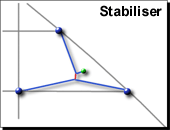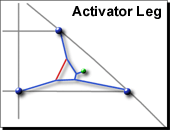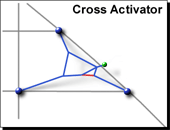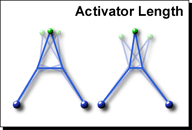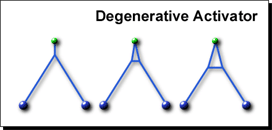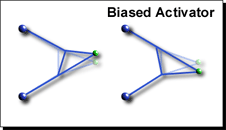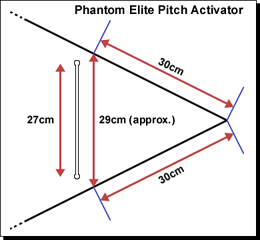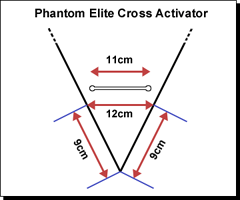Dihedral Active Bridle
The Dihedral Active Bridle is easier to design and tune than the original Active Bridle, although slightly more time consuming to construct, having two activators instead of one (hence the name). It tends to be well suited to larger kites that expect more precise control. This page describes the Dihedral Active Bridle and compares it to the original Active Bridle. It shows the construction of a Dihedral Active Bridle, providing measurements for the Phantom Elite by way of example.
The Active Bridle is a dynamic bridle configuration which imparts some desirable flight characteristics on a wide range of dual line kites. At the time of writing, the bridle has been deployed on a number of different kites with very encouraging results.
In designing Active Bridle configurations for various kites, the primary drawback of the bridle has become increasingly apparent. That is, that in some cases it can be difficult to precisely tune the bridle to achieve the desired result. This is due to the bridle, and in particular, the the length of the Stabiliser leg and the attachment position of the Stabliser along the lower leg, being particularly sensitive to adjustment.
This paper introduces the Dihedral Active Bridle which alleviates this problem by replacing the Stabliser leg with a second Activator leg connected between the lower legs of the bridle. Whilst this doesn't fully emulate the behaviour of the standard Active Bridle, it does increase the stability and precision of the kite, produce a smoother transition between tracking, turning and tricking. More importantly, it makes the bridle more robust, easier to design and less sensitive to minor adjustments. Furthermore, the Dihedral Active Bridle configuration can be applied to a kite with an existing static bridle by a quick and simple modification process.
The only significant compromise is that the Dihedral Active Bridle tends to create less stability in stalls and slides than an original Active Bridle. A notable improvement is gained over a static bridle, however, and this effect can be varied to some degree by the placement of the second Activator leg.
The overall effect of the Dihedral Active Bridle is to create a kite which is very smooth to fly in both standard "precision-like" flying and when performing freestyle and trick maneuvers. The kite feels more positive and imparts a better feedback response to the flier.
The Active Bridle can be considered to be a static bridle with two extra elements added. These are known as the "Stabiliser" and the "Activator" legs.
The Stabliser makes a connection between the upper leg and the lower legs and is shown highlighted in red on Diagram 1. The function of this element is to introduce a lateral instability in the tow point that allows it to move in towards the spine or out towards the leading edge, depending on differences in tension in the flying lines. In effect, the tow point is pulled in when the kite is flown in a straight line and thus increases the tracking precision of the kite. When one flying line is pulled, the tow point under influence moves out and thus improves the kite's turning characteristics.
The second additional leg, known as the "Activator" and shown in red on Diagram 2, connects the inner and upper legs together, pulling them in slightly. This serves to give the kite "Pitch Control" and allows the nose to move forwards or backwards by a small amount, depending on the wind, relative position of the kite in the window and tension, or lack of it (in a stall, for example) in the flying lines. This gives the kite better speed control and a smooth, responsive feel in flight.
The two legs when applied in combination in a standard Active Bridle have a synergy that imparts a number of desirable features on the flight characteristic of the kite. Either leg, when used in isolation, has a noticeable benefit, but it is the combination and inter-working of the two that produces the final result.
The main limitation of the standard Active Bridle is that it can be sensitive to adjustment. This is particularly true of the Stabiliser leg - its length and connection point along the lower legs are critical to achieving good overall results. The situation is not as dire as it may first appear, and it should be noted that an "imperfect" Active Bridle may still have many wonderful features even if it doesn't necessarily improve all the characteristics of the kite. In other words, you might not make the kite perfect, but you can certainly make it better.
The design of the kite itself is not only fundamental to the way it flies, but it also determines quite clearly what any bridle will and will not be able to achieve. An Active Bridle can improve a good feature or limit a bad one and to some degree, may even give a kite a characteristic that it may not appeared to have previously had (the Box of Tricks being able to hold a controlled, extended stalled, for example). On the whole, it is the kite that determines what can and can't be done and the bridle exists to incorporate as many good features and as few bad ones as possible. It is also the role of the bridle designer to align these idioms in such a way that different features are enhanced for different modes of flight. The archetypal example of this is the movement of the tow point (via the Stabliser) in or out, to improve tracking or turning, depending on whether the kite is being flown in a straight line or in a turn.
The versatility of a kite to perform in different ways thus dictates how effective an Active Bridle will be. Some case studies may illustrate this point:
- Trick Kite
- The Box of Tricks (Benson Kites) is a pure trick/freestyle kite and gives a radical performance while maintaining some elements of controllability and precision. The Active Bridle enhances the freestyle elements and simultaneously improves the tracking, speed control and ability to stall the kite. The kite was never designed to fly stable, slow precision figures and as such, the bridle design is tolerant. We don't have to find the perfect balance between precision and trick-ability to achieve the desired result. The very precise end of the range can be compromised because the nature of the kite doesn't require it.
- Team Kite
- A kite designed for team flying is typically very stable and precise, perhaps at the cost of maneuverability. This may leave much to be desired in terms of what the kite can achieve in freestyle and trick flying. An Active Bridle can be used to improve the radical performance of the kite and give other benefits in terms of speed control, responsiveness, and stability and persistence in stalls and slides. We can afford to emphasise the radical aspects of the bridle and rely on the natural precision of the kite to provide a wider spectrum of flight ability without compromising any of the original characteristics.
- Freestyle Kite
- An all-round freestyle kite such as the Outer Space (Benson Kites) is designed to give the best of both worlds by offering precision and advanced trick capabilities. The Active Bridle was developed originally on a series of prototype Outer Space kites and previous incarnations known internally as the Phantom Freestyle. This kite, and this class of kite, has proven to gain the most advantage from an Active Bridle which can emphasise flying characteristics for both precision and trick flying. This represents the greatest challenge in finding the correct bridle implementation that is well balanced between the two extremes. The fact that the kite is so versatile only emphasises the amount by which the bridle can change its nature. Whilst this gives an extensive latitude to what the kite is capable of achieving, it makes it harder for the bridle designer to define where in that spectrum the correct point should be. The complexity of the Active Bridle effectively prevents many people from understanding and utilising the range of effects that adjusting the bridle can give.
The movement of the tow point in or out is dictated by the length and position of the Stabiliser and is directly influenced by the absolute and relative tension on the flying line. The absolute tension relates to the amount of pressure exerted on both lines and changes with natural wind speed fluctuations, as the kite flies through the wind window and also in special conditions such as stalls. The relative tension relates to the difference in pressure on the lines as characterised by the kite flying in a straight line or turning.
To achieve our goal of maximum versatility from the kite, the bridle should be designed such that the movement of the tow point, with all bridle lines remaining under tension, is enough to change the characteristics of the kite as much as, but no more than desired.
The Stabiliser configuration permits movement of the tow point when the bridle is under tension, but has a sensitivity that may make the kite may switch too quickly from one extreme to the other in response to user input. Thus, small changes in the absolute or relative tension on the lines can result in excessive behaviour changes in the kite that make it more versatile, but less predictable. This effect is more pronounced in kites that are naturally more responsive.
In many ways, this behaviour is entirely desirable. The Outer Space characterises this by exhibiting a number of distinct flying "modes", some of which are:
- Straight Flight
With equal and firm pressure on the lines, the kite tracks well as the bridle locks into a position in which the tow points are moved in. - Turn/Spin
Increasing the pressure on one line will move the tow point out to a position where the kite spins fast and smoothly. - Stall
In a stall, the lack of pressure on the lines drops the nose forwards (reducing the effective area of the kite in the wind and thus helping to maintain the stall) and moves the tow points out and up, making stalls and slides easy to maintain and control. - Fade
In a Fade (kite hanging face up in the air with the nose pointing towards the flier), the slack in the lines moves the tow points further out allowing the bridle to cross the leading edge at a lower position. This allows the nose to rise slightly and helps to sustain the kite in this position.
Because the bridle allows the kite to switch quickly and crisply from one mode to another, the flier can combine different flying styles and elements cleanly and with ease. For more traditional precision-based flying, this response may be deemed too sensitive. A better compromise would be to require greater user input to influence the kite. Whilst this might make the kite harder to control in the sense that the flier must do more to utilise the full versatility of the kite, it has the benefit that the kite becomes more predictable and less likely to over-react to inaccurate control or dynamic natural conditions (gusting wind, for example).
The Dihedral Active Bridle is presented here as one such solution to the problem of over-sensitivity in the Active Bridle. Instead of adding a Stabiliser leg to a static bridle, a second Activator leg, the Cross Activator, is added between the lower bridle legs. The other Activator is added between the inner and upper legs as per the standard Active Bridle. The Cross Activator is shown in red on Diagram 3.
One notable elegance of this design is that a static bridle can be modified to a Dihedral Active Bridle by simply adding the two Activator legs between the upper and inner legs (known simply as the Activator in the standard Active Bridle, but perhaps best named explicitly as the Pitch Activator) and the two lower legs (the Cross Activator). There is no need to remove the bridle from the kite or disconnect bridle elements from each other.
The Cross Activator has the same effect as the Stabiliser in allowing the tow point to move in and out when the bridle is under tension, but with greater control over the distance and direction of movement. The Pitch Activator works in an identical manner, controlling the movement of the tow point up and down.
In either case, shortening the Activator leg allows more movement in the tow point and lengthening it has the opposite effect. This is shown in Diagram 4.
The distance between the bridle lines increases as the Activator is moved away from the tow point. An Activator leg of a given length will therefore pull the bridle legs in by more when placed further away, creating a greater movement at the tow point. An Activator moved towards the tow point will create less movement. This is shown in Diagram 5.
It should be noted, however, that shortening the Activator and moving it further away (or vice versa) are not necessarily equivalent. As the tow point moves, it is effectively rotating around an imaginary point in the centre of the Activator. The further away from the tow point that the Activator is placed, the greater the effective radius of this circle of rotation. This is shown in Diagram 6.
A tow point that rotates around a circle of a smaller radius (i.e. Activator positioned closer to tow point) will change the characteristics of the kite more quickly. In the case of a Cross Activator, this will allow the tow point to shift rapidly from an inner position (when tracking) to an outer one (when turning). A Cross Activator set further from the tow point and lengthened accordingly to give them same movement in the tow point, will produce a slower transition from one position to another, giving a smoother, more consistent and stable kite.
The Pitch Activator generally provides less scope for adjustment. Typically set long and some distance from the tow point, it should allow enough change in the pitch of the kite to improve speed control and smooth out gusts but not so much as to cause the nose to rock forwards excessively.
We can summarise that in the general case:
The Stabiliser section on the standard Active Bridle can be thought of as the by-product of a degenerate Cross Activator which has been placed close to the tow point and reduced to zero length. The adjacent bridle lines are effectively tied together and continue as a single unit to the tow point. From the summary above, we can see that we have a very short (0 length, in fact) Activator which pulls in the adjacent bridle legs until they meet, creating a notable amount of movement in the tow point. It is also placed close to the tow point creating a small circle of radius. This is likely to further increase the effect of the bridle and make it sensitive to slight changes in line pressure.
To reduce the over-responsiveness created by this configuration, we move the Activator further away from the tow point and extend its length until it creates approximately the same amount of movement in the tow point. This is shown in Diagram 7. Although we have the same amount of sideways movement in the tow point as before, the circle of rotation is much larger. The kite should still perform as well throughout the range of characteristics provided by the bridle, but the transition between one bridle position and another will be slower and smoother. This should create a kite that is as versatile as before, but less sensitive and more predictable.
By fixing an Activator at unequal distances from the tow point, we angle it in a particular direction and cause it to bias the tow point to move in one direction rather than the other. The tow point will naturally align itself to the side on which the Activator is closest.
This effect can be of particular use in the Pitch Activator to adjust the kite for different wind conditions. By moving the top end of the Pitch Activator slightly closer to the tow point than the bottom end, the tow point is moved up slightly, increasing the kite's performance in lighter wind. The top end of the Pitch Activator can be moved further away to lower the tow point for better performance in higher winds. This is shown in Diagram 8.
The same adjustments can be applied to the Cross Activator to quickly tune the tow point further in or out, which in the general case, will improve the tracking or the turning respectively. This same effect would be achieved on the standard Active Bridle by moving the connection point of the Stabiliser in or out along the lower legs. The Dihedral Active Bridle allows these adjustments to be made more easily and without affecting the relative lengths of the static bridle on which it may be constructed.
The Dihedral Active Bridle shares many of the flight characteristics of the standard Active Bridle. Specifically, the kite has better speed control, improved tracking, smoother turning and advanced freestyle and trick capabilities. The Dihedral Active Bridle is generally less sensitive to flier control and so gives a smoother transition between these different flying modes. Sensitivity in a bridle is a Good Thing, but too much can be as bad as too little. The major advantage of the Dihedral Active Bridle over its standard counterpart is that the sensitivity can be reduced (or increased) on demand to match the individual flier's preferences or specific conditions.
A further benefit of the Dihedral design is that the cross-bracing effect of the Activator legs makes the bridle inherently more stable in itself. The bridle stays under tension better than the standard Active Bridle, giving more immediate response from the kite in response to input and better feedback from the kite back to the flier. This can reduce the "juddering" effect that can sometimes be experienced under strong wind conditions and also greatly reduces wobble in the kite (most noticeable in the wing-tips) during sharp turns.
Freestyle performance is also greatly improved, as per the standard Active Bridle. The smoother transition in to and out of tricks makes it is easier to consistently perform advanced freestyle moves and to get them cleaner, smoother and more controlled. In particular, Multiple Axels, Flat Spins and similar tricks become easier to perform as the bridle allows continual flier input during the trick without disrupting the orientation of the kite. The kite tends to remain flatter for longer, even as the flier gives further input to rotate it around. At the end of the trick, the kite should provide a smooth transition out of a flattened orientation back into normal flight.
The design of the Active Bridle(s) is such that the tow point can move, in a controlled fashion, to positions in which the kite would never normally fly. This extreme movement under certain conditions opens the door for many new freestyle tricks that simply wouldn't be possible on a kite with a static bridle.
A Dihedral Active Bridle can be constructed by a simple modification to an existing static bridle. The technique described below has the advantage of being easy to adjust and allows the underlying static bridle to be tuned in the normal way even after the Activators have been added.
The two Activator legs are constructed from raw (unsheathed) Spectra line. Line rated at around 70kg (~150lb) breaking strain should be ideal. Raw Spectra is used because it interacts well with the sheathed bridle line as used on most conventional bridles. The Activator connection points should tighten hard enough around the bridle line to prevent slippage in normal flight while still allowing easy and quick manual adjustment when a little force is applied in the right direction. The combination of sheathed and raw Spectra seems to fit this requirement well.
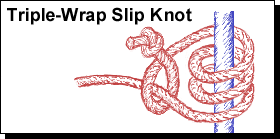
|
|
Diagram 9 Triple-Wrap Slip Knot |
The Activator legs should have single overhand stopper knots tied in each end. The Activator line should be passed 3 times around the bridle line and then finished in the same way as a Slip Knot. See Diagram 9. Each end of an Activator is connected to a different bridle leg: the Cross Activator to the lower legs on either side of the tow point, the Pitch Activator to the upper and inner legs.
When pulled tight, the Activator leg should remain in position on the bridle line. The Activator can be moved by holding the knot and sliding it (with a little force) up or down the bridle line. Check that the Activator knots are tight after adjusting to avoid further slippage. This can be done by grabbing the bridle lines at either end of the Activator and pulling them apart to tension the Activator leg.
The Phantom Elite (Benson Kites) is presented here as an example of a specific conversion to a Dihedral Active Bridle. The standard static bridle has legs which are approximately 58.5cm, 65cm and 67cm for the upper, inner and outer legs respectively, when measured on the kite (i.e. no account made for knots). The action of the Cross Activator in pulling in the lower legs has the effect of lowering the tow point slightly. To compensate we start by moving the tow point up by 2cm. The outer and upper legs are constructed from a single piece of bridle line and this adjustment gives us new upper and outer lengths of approximately 56.5cm and 69cm respectively.
In the general case, the Pitch Activator should be a little shorter (approximately 75%) than the distance between the bridle legs at the point at which it will be attached. A good starting point for attaching the Pitch Activator is to place it at the midpoint of the upper leg and the same distance down from the tow point on the inner leg.
On the Phantom Elite, the Pitch Activator is placed 30cm down from the tow point on both these legs. The distance between these points when the bridle is under tension is approximately 29cm. 75% of this length is (roughly) 22cm. We then add a further 5cm to account for knots, giving a total length of 27cm. Tie a single overhand stopper knot in a length of Spectra and another one 27cm down from that. Trim the line just outside the knots and seal the ends with a lighter.
The Cross Activator should be 11cm in length between stopper knots with trimmed and melted ends as per the Pitch Activator. In the general case, the Cross Activator should be about half the length (approximately 50%) of the distance between the lower bridle legs at which it will be attached.
In the case of the Phantom Elite, we choose a point 9cm down from the tow point at which the bridle legs are approximately 12cm apart. Half this distance gives us 6cm to which we add 5cm to account for knots. This gives us a total length of 11cm.
The ends of the Cross Activator are tied to the outer and inner legs of the bridle, 9cm down from the tow point (tie first, adjust later). The Pitch Activator is tied to the upper and inner legs, 30cm down from the tow point. Pull the Activators taught to tension the knots.
Your kite has been Activated. Nice one.
The table below gives a summary of the lengths of each leg of the Dihedral Active Bridle for the Phantom Elite.
|
Phantom Elite (Benson Kites)
Dihedral Active Bridle Copyright © 1997-2006 Andy Wardley | ||
|---|---|---|
| Kite | Phantom Elite | |
| Manufacturer | Benson Kites | |
| Bridle Designer | Andy Wardley | |
| Bridle Version | 1.0 (official) | |
|
Static Bridle
(Spectra core bridle line) |
Length
(measured on kite) |
|
| Upper Leg | 56.5 | |
| Inner Leg | 65 | |
| Outer Leg | 69 | |
|
Activators
(~75kg unsheathed Spectra) |
Length
(end to end) |
Distance
(from tow point) |
| Pitch Activator (x2) | 27 | 30 |
| Cross Activator (x2) | 11 | 9 |
Having constructed the Dihedral Active Bridle, the first task is to make any necessary adjustment to the tow point to get the kite flying correctly. With the Phantom Elite bridle detailed above, the tow point should be in approximately the correct position, requiring little or no adjustment. Because the Active Bridle configurations give a kite a slightly wider wind range than a static bridle, you may find that when properly adjusted, the tow point can be left as set and the kite will perform well throughout its normal wind range. One advantage of the Dihedral Active Bridle is that the tow point can be subsequently adjusted for different wind conditions or flier preference. The Activator positions are affected by this but can be easily corrected to account for the change.
Adjustment of the tow point is performed as per a static bridle. A typical static bridle configuration (and that used on the Phantom Elite) consists of a single piece of line used for the outer and upper legs, attached by a lark's head onto a separate piece of line which constitutes the inner leg. The tow point is adjusted by loosening the lark's head and moving its position up or down the outer bridle line.
A kite that is bridled too low will typically lack forward drive and tend to spin fast with over-steer. In this case, the tow point should be moved up. A kite that is bridled too high (up to a point) will fly fast, perhaps overshooting at the sides or top of the window. It will create less pressure on the lines and may be difficult to turn. In this case the tow point should be moved down slightly.
Moving the tow point changes the relative lengths of the outer and upper legs. After each adjustment, the position of the Activators attached to these legs must be corrected to account for the change. Simply slide the Activator knot up or down the bridle line and pull tight when in the correct position.
Having adjusted the tow point to the correct position, you can now start to adjust the Activators to find a suitable position (or positions) for the kite. The dimensions given for the [ phantom ] should create a bridle that has a noticeable "Active Effect" without being too extreme. This bridle configuration allows you to quickly try different Activator positions and then revert back to a known, stable position if necessary.
The Pitch Activator is used to control the pitch of the kite. Moving it away from the tow point will cause more movement in the nose of the kite. Moving it towards the tow point will lessen the effect up to the point (when the Activator is slack) where it has no effect at all. Too much movement in this direction will cause the kite to rock forwards and backwards excessively.
The Pitch Activator can also be set biased to enhance the kite's performance in lighter or stronger wind without moving the tow point. Moving the top of the Activator (on the upper) leg towards the tow point will improve the kite's performance in lighter wind by moving the tow point up slightly. Moving it away will lower the tow point slightly for higher winds. A typical adjustment may be to move the upper knot by a few centimeters (2 to 5cm, for example) in either direction.
The Cross Activator is used to control the lateral (sideways) movement of the tow point. Moving the Activator towards the tow point reduces the effect, moving it away increases it. Too much movement in this direction may cause excessive spinning in the kite and in the extreme case, the tow point may move so far out in a tight spin that the kite completely "washes out". In this case, the Activator should be moved towards the tow point to lessen the effect. When set correctly, the kite should track solidly and still turn smoothly. Depending on the characteristics of the kite, you may also notice an improvement in stalls (the tow points shift out to stabilise the kite) and a smoother transition into and out of tricks.
Note that moving the Cross Activator away from the tow point pulls in the lower legs and causes the tow point to lower slightly. The tow point may therefore need slight adjustment for significant changes in the Cross Activator position.
The best advice one can give to those interested in understanding the full effects of the Dihedral Active Bridle is to experiment. With this configuration, it is possible to slide the Activators down towards the tow point until they have no effect and then gradually introduce each Activator in turn to see the effect that it has on the kite. It should be noted that the two Activators work in conjunction to create some specific flight characteristics that cannot always be broken down to the effect of one or the other Activator. Therefore, it is not possible to fully understand the bridle by examining the elements in isolation, but it does give a good basic understanding of what effects the Activators have, and how they might be combined to give the desired characteristics for the individual flier.
